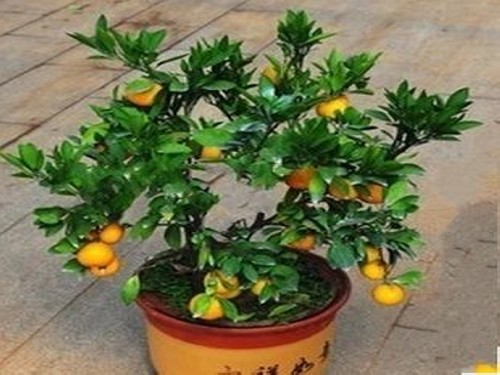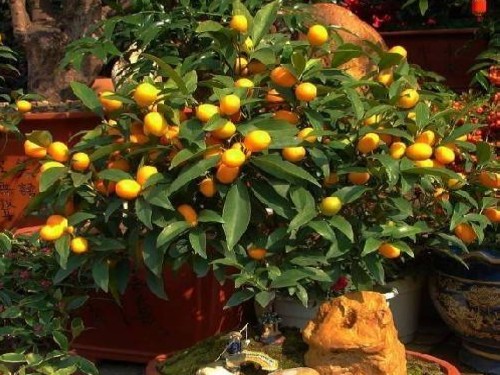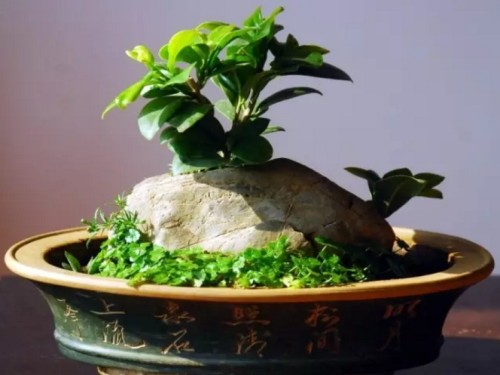How to cultivate bonsai in orange trees
Many flower friends like the golden orange tree, but when they buy it, they don't know how to raise the kumquat tree, either losing the leaves or falling the fruit. In fact, it is not that the kumquat tree is difficult to grow, but it needs a process of adaptation. The potted plants bought by flower friends must have been raised in pots all the time, but they were temporarily transplanted. The orange tree is an evergreen shrub of the citrus genus of Rutaceae, with its origin in China, evergreen in four seasons, dense branches and leaves, neat tree posture, full of fragrant flowers in spring, numerous yellow fruits in autumn and winter, and extremely beautiful yellow and green colors. In addition to being used for fruit cultivation, its potted ornamental is also very popular. Let's take a look at how to raise potted orange trees.
Orange trees in the daily maintenance process should pay attention to prevent flowering rain, and do not spray water on the blooming flowers, which is not conducive to pollination, but also easy to cause rotten flowers. Oranges like warm, humid and sunny environment, which is placed in the lack of indoor sunlight for a long time, resulting in weak plant growth, affecting flower bud differentiation and fruiting.

Due to the inhibition of the root system of potted oranges, although there is no shortage of nutrients in the pot, the nutrient supply of the root system to the plant is still limited, so it is inevitable to lose fruit, so it is better to take the method of actively thinning flowers and fruits to save waste of nutrients. The number of fruits should be determined according to the specific circumstances. Generally in the axilla of the same leaf, sometimes 8 flower buds are produced, one can be left; 2 to 8 buds and 1 to 2 fruits are left on each branch. Orange flowering and fruit-setting period should not be watered, stable fruit before normal watering, but can not accumulate water in the basin to avoid fruit drop.
[container selection]
The containers of potted orange trees are mainly round, so that the roots can spread evenly around. At the same time, the containers need water seepage and good air permeability to ensure the oxygen demand for root growth and prevent the rotting roots caused by stagnant water in the container. Among all kinds of texture containers, sukiyaki pot is the most suitable for planting orange trees. When using other texture containers, in order to overcome the disadvantage of poor air permeability, you can lay 5 cm thick coarse sand at the bottom of the basin, pad a layer of new tiles along the inner wall, and then fill the soil to plant trees.
[preparation of basin soil]
The basin soil suitable for orange tree growth is generally neutral (PH value is 4.5-7.5), sandy loam or sandy soil rich in humus. When preparing, 4 parts of ripe pastoral soil, 2 parts of river sand, 1 part of plant ash, fully mixed evenly, crushed and screened. The culture soil should be disinfected before use, such as cooking disinfection, baking disinfection or medicine (1.5% formalin) disinfection.
[fertilizer and water management]
1. Watering: the pH value of water is generally 6.5-7, which can be corrected by ferrous sulfate. The difference between water temperature and soil temperature should not exceed 5 ℃. Watering in the growing season is carried out before 10:00 or after 4 p.m. Water once a day on a sunny day in summer, if the soil is dry, make up water again on the same day, water once a day in spring and autumn, water every 2-5 days depending on soil moisture in early spring and late autumn, and control watering in winter.
2. Fertilization: potted orange trees should be fertilized frequently because of trees, days, and thin soil. Potted plants with strong fertilizer tolerance, large growth and more fruit should be fertilized more, otherwise less fertilizer should be applied, no fertilizer should be applied during the dormant period, more fertilizer should be applied to those with low fertilizer content or long-term potted soil, and less fertilizer should be applied to those with high fertilizer content.
[controlled crown plastic surgery]
1. Tree shape selection: the tree shape of potted orange trees can be shaped with rich imagination, such as natural round head shape, tower shape, single-branch cliff shape, two-branch deer horn shape, three-branch cup shape, weeping willow shape, dragon curve shape, etc., according to the different requirements of fruit tree species and varieties, such as upright and sagging. It should not only be beneficial to the result, but also have aesthetic effect and improve its ornamental value.
2. Spray shaping: foliar spraying plant growth retarder (such as dwarf, paclobutrazol, etc.) should be sprayed for 2 or 3 times in the vigorous growth period of potted orange trees in summer, which can make the branches stout, internodes shorter and plants dwarf. In addition, the main measures to promote flower dwarfing and shape pruning are wiping buds, coring, taking branches, curved branches, ring cutting, retraction, renewal, pulling branches and so on, and enhance the light by opening branch angle and thinning long branches, dense branches and ineffective branches to form an ideal tree shape.
[pour the pot at the right time]
Because the nutrients in the potted soil are absorbed by the fruit trees or washed away in frequent watering, the potted orange trees need to pour the pots in time every 2-3 years to replace the new nutrient soil. After the soil mass is deducted upside down, cut off the old root of 2 cm thick around the basin soil, mix the organic fertilizer and nutrient soil well to fill the bottom, then bring the soil mass to the basin, and then add the fertile soil around to fill it, and pour water once.
[lighting management]
Orange trees prefer a warm and humid climate with plenty of sunshine and should be placed in a sunny place when conserving. If the light is not enough and the environment is shaded, it will often cause branches and leaves to grow, blossom and bear fruit less. As oranges like cool climate in summer, or high intensity of summer sunshine, it is better to put them in the shade at this time.
[prevent the cold from overwintering]
Orange trees like warm and refreshing growth temperatures. When the temperature is below 10 degrees Celsius at the end of autumn, they should move indoors in time. It is best to keep the room temperature at 6 to 12 degrees Celsius in winter. If the temperature is too low, it is easy to suffer frost damage. Too high will affect plant dormancy and is not conducive to flowering and fruiting in the coming year. In the case of no frost damage in winter, generally do not overwinter indoors, let it hibernate naturally outside. In order to prevent frost damage, the soil can be watered once before freezing, and then the whole container can be wrapped with a straw bag to protect against cold, or ditches can be dug and buried.
[diseases and insect pests]
The main diseases and insect pests of orange trees are: Huanglong disease, anthracnose, scab, red spider, rust spider, leaf moth, shell worm.
For the prevention and control of citrus diseases, most fruit growers are accustomed to chemical control, adhere to the prevention-oriented, combined plant protection policy, but ignore the comprehensive control. Comprehensive control includes starting from plant health, reasonable fertilization, balancing tree nutrition, improving plant disease resistance and immunity, reducing the use of pesticides, and maintaining ecological balance.
For the prevention and control of citrus diseases, in addition to timely control, supplementary application of nutrient elements can improve plant resistance and disease resistance, repair slight bacterial infection, and increase the preventive and therapeutic effect of chemicals.
Time: 2019-06-01 Click:
- Prev

Management of potted orange trees
Orange tree bonsai should be placed outdoors, pay attention to strengthen ventilation, receive sufficient direct sunlight. To keep the basin soil moist, do not lack water, water. Also do not because basin soil hardening, water flow is not smooth, and lead to basin soil waterlogging. Potted orange trees should be consciously cultivated to bear more autumn fruits for appreciation during the Spring Festival
- Next

Why did the banyan bonsai lose its leaves? What if the leaves of the banyan bonsai fall?
Banyan bonsai is one of our most common bonsai. It is evergreen, graceful and easy to maintain. After years of conservation of banyan bonsai, I feel that its more common problem is falling in love with leaves. Once her daughter put one of the banyan bonsai into her room, which had only been in the room for two days.
Related
- Fuxing push coffee new agricultural production and marketing class: lack of small-scale processing plants
- Jujube rice field leisure farm deep ploughing Yilan for five years to create a space for organic food and play
- Nongyu Farm-A trial of organic papaya for brave women with advanced technology
- Four points for attention in the prevention and control of diseases and insect pests of edible fungi
- How to add nutrient solution to Edible Fungi
- Is there any good way to control edible fungus mites?
- Open Inoculation Technology of Edible Fungi
- Is there any clever way to use fertilizer for edible fungus in winter?
- What agents are used to kill the pathogens of edible fungi in the mushroom shed?
- Rapid drying of Edible Fungi

